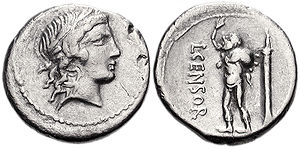- Denarius of L. Censorinus
-
In 82 BC, a denarius was minted by Lucius Marcius Censorinus picturing Apollo and Marsyas the satyr. The coin has attracted several interpretations because of the ambiguity of its symbolism.[2]
Contents
Coin description
On the obverse of this coin is a representation of the god Apollo, portrayed as a young man wearing a diadem. On the reverse of the coin is an image of the satyr Marsyas, nude, carrying a wineskin.[2] He is wearing a Phrygian cap, and has a pedestal standing beside him, holding a statue, which some think is a statue of Minerva.[3] Along the side is the inscription L. Censor.[2] The image of Marsyas may be copied from a statue in the forum of Rome at this time, as implied by the pedestal in the field of the coin.[4] The coin is silver and weighs roughly 3.95 grams.[2]
Symbolism
The Marcius gens
The symbolism may refer to the moneyer’s family line, the gens Marcia, who claimed legendary descent from Marsyas.[5] An ancestor claimed to have experienced a vision which led to the founding of games in tribute to Apollo. The brother of Lucius, Gaius Marcius Censorinus, minted a coin with the image of Apollo.[6]
Political climate
- Main discussion: Marsyas, Prophecy and free speech at Rome.
Another view of the symbolism in this coin is that it is politically driven.[7] Apollo was seen as a symbol of harmony, especially in his manifestation at Rome.[8] During this time, Rome was experiencing a period of political upheaval, connected to the Social Wars.[8] Marsyas was regarded as a symbol of political freedom, particularly free speech. On the coin, Marsyas is wearing a Phrygian cap, a symbol of liberty.[9]
L. Marcius Censorinus was a supporter of Marian or Cinnan politics, which advanced the cause of Roman citizenship for Italians during the Social Wars.[10] Gaius Marcius Censorinus was captured at the Battle of Colline Gate and beheaded by an order of Sulla, the champion of the senate's traditional privileges.[11] Many other supporters of Marian politics used images of Apollo on their coins, often in conjunction with images of Saturn, Venus and a god who is known as a young[clarification needed] Jupiter.[12]
Warding off plague?
The image of Apollo on the coin may refer to the plague of 87 BC. Censorinus may have been invoking the god in his capacity as a healer and protector.[13]
References
- ^ cngcoins.com
- ^ a b c d coinarchives.com
- ^ Rowland, Robert J. Jr., Numismatic Propaganda under Cinna Transactions and Proceedings of the American Philological Association. Vol. 97 (1966) pp. 407-419 pg. 417, coinarchives.com
- ^ Babelon, Ernest. Description Historique et Chronologique des Monnaiees de la Republique Romaine Vulgairement Appelees Monnaies Consulaires. Arnaldo Forni, Bologna 1963, pg. 194-195
- ^ Babelon, Ernest Description Historique et Chronologique des Monnaiees de la Republique Romaine Vulgairement Appelees Monnaies Consulaires. Arnaldo Forni, Bologna 1963, pg. 194-195
- ^ Kent, J.P.C. Deputy Keeper Dept. of Coins and Medals, the British Museum, Photographs by Max and Albert Hirmer Roman Coins, Thames and Hudson Ltd, London 1973, pg 268.
- ^ Luce, T.J. Political Propaganda on Roman Republican Coins: Circa 92-82 B.C. American Journal of Archeology, Vol. 72, No. 1 (Jan., 1968) pp. 25-39, pg 26.
- ^ a b Luce, T.J. Political Propaganda on Roman Republican Coins: Circa 92-82 B.C. American Journal of Archeology, Vol. 72, No. 1 (Jan., 1968) pp. 25-39, pg 32-33
- ^ Rowland, Robert J. Jr., Numismatic Propaganda under Cinna Transactions and Proceedings of the American Philological Association. Vol. 97 (1966) pp. 407-419, pg 417
- ^ Rowland, Robert J. Jr., Numismatic Propaganda under Cinna Transactions and Proceedings of the American Philological Association. Vol. 97 (1966) pp. 407-419, pg 407-408
- ^ Luce, T.J. Political Propaganda on Roman Republican Coins: Circa 92-82 B.C. American Journal of Archeology, Vol. 72, No. 1 (Jan., 1968) pp. 25-39, pg. 29
- ^ Luce, T.J. Political Propaganda on Roman Republican Coins: Circa 92-82 B.C. American Journal of Archeology, Vol. 72, No. 1 (Jan., 1968) pp. 25-39, pg. 25.
- ^ Luce, T.J. Political Propaganda on Roman Republican Coins: Circa 92-82 B.C. American Journal of Archeology, Vol. 72, No. 1 (Jan., 1968) pp. 25-39, pg. 33
Categories:- Coins of ancient Rome
Wikimedia Foundation. 2010.

